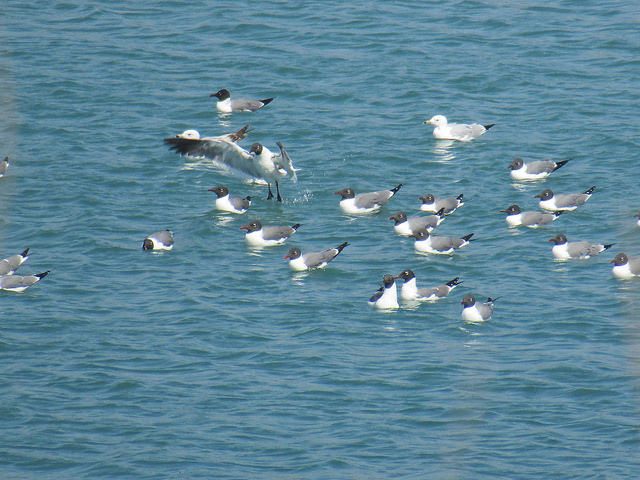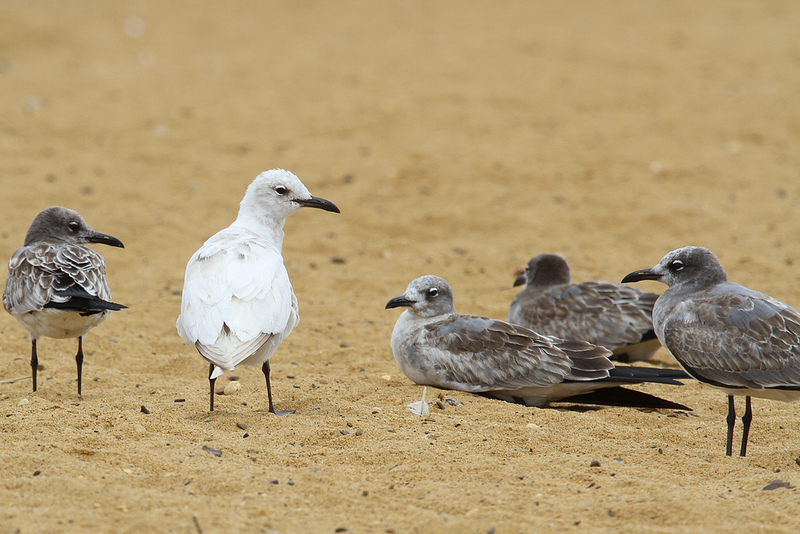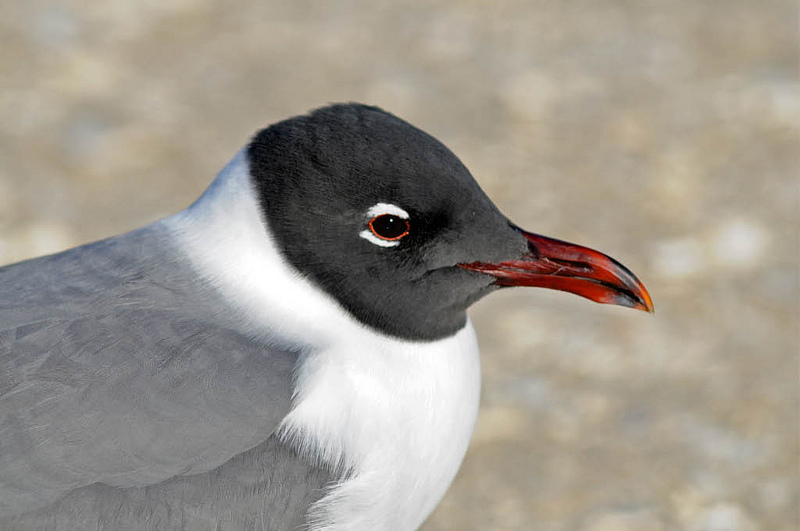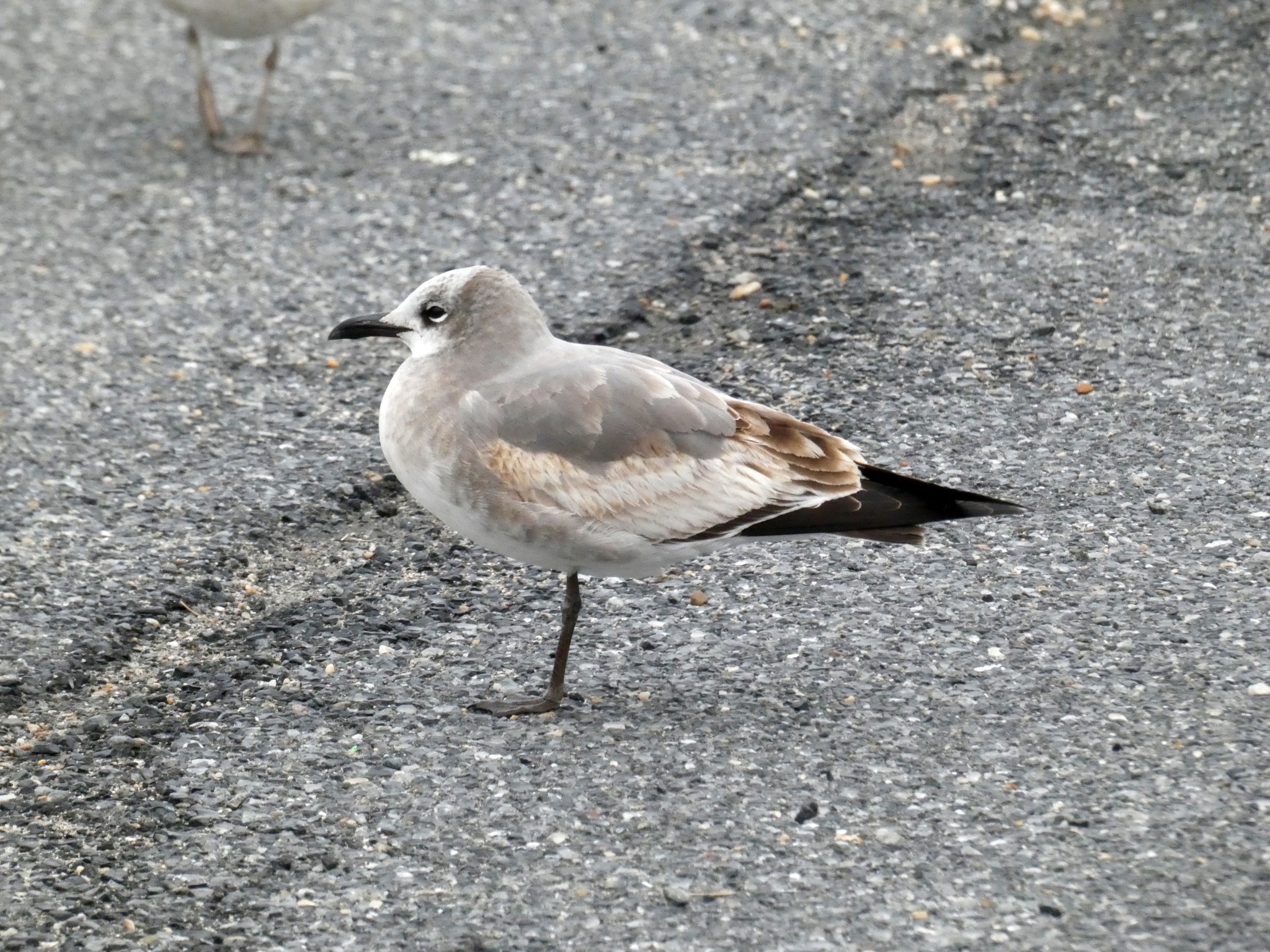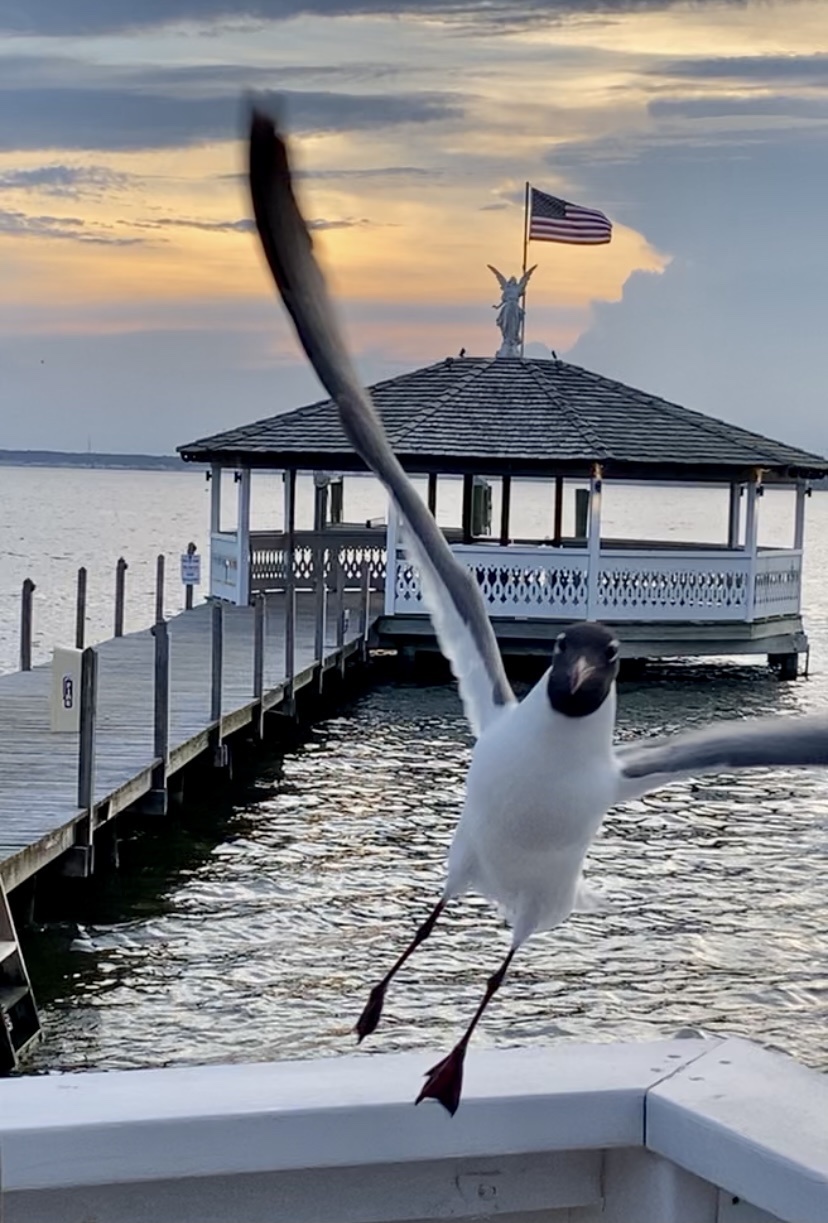Map Snapshot
























1,048 Records
Laughing Gull in Anne Arundel Co., Maryland (4/15/2012). (c) Bill Hubick, all rights reserved. - Bill Hubick.
Status
Abundant on the coastal plain in summer. They become uncommon and then very rare as one moves west from the coastal plain.
Seasonality Snapshot
Source: Wikipedia
| Laughing gull | |
|---|---|

| |
| Call | |
| Scientific classification | |
| Domain: | Eukaryota |
| Kingdom: | Animalia |
| Phylum: | Chordata |
| Class: | Aves |
| Order: | Charadriiformes |
| Family: | Laridae |
| Genus: | Leucophaeus |
| Species: | L. atricilla
|
| Binomial name | |
| Leucophaeus atricilla | |

| |
| geographical range
breeding year-round nonbreeding
| |
| Synonyms | |
|
Larus atricilla Linnaeus, 1758 | |
The laughing gull (Leucophaeus atricilla) is a medium-sized gull of North and South America. Named for its laugh-like call, it is an opportunistic omnivore and scavenger. It breeds in large colonies mostly along the Atlantic coast of North America, the Caribbean, and northern South America. The two subspecies are L. a. megalopterus — which can be seen from southeast Canada down to Central America — and L. a. atricilla, which appears from the West Indies to the Venezuelan islands. The laughing gull was long placed in the genus Larus until its present placement in Leucophaeus.
Taxonomy
[edit]The laughing gull was formally described in 1758 by the Swedish naturalist Carl Linnaeus in the tenth edition of his Systema Naturae under the binomial name Larus atricilla.[2] Linnaeus based his account on the "laughing gull" from the Bahamas that had been described and illustrated in 1729–1732 by the English naturalist Mark Catesby in his The Natural History of Carolina, Florida and the Bahama Islands. The laughing gull is now one of five New World gulls placed in the genus Leucophaeus that was introduced in 1855 by the German ornithologist Carl Friedrich Bruch.[3] The genus name Leucophaeus is from Ancient Greek leukos meaning "white" and phaios meaning "dusky". The specific epithet atricilla combines Latin ater meaning "black" with Modern Latin cilla meaning "tail". It is possible that Linnaeus intended to write atricapilla meaning "black-headed".[4]
Like most other members of the genus Leucophaeus, the laughing gull was long placed in the genus Larus. It was moved to the resurrected genus Leucophaeus based on a 2005 molecular phylogenetic study that found that inclusion in Larus made that genus paraphyletic.[5][6]
Two subspecies are recognised. They are listed below with their breeding ranges.[3]
| Image | Subspecies | Distribution |
|---|---|---|
 |
L. a. megalopterus (Bruch, 1855) | islands off west North Atlantic coast of southeast Canada (sporadic or formerly), Maine to Florida, Gulf of Mexico to south Texas, Salton Sea (southeast California; formerly), Gulf of California to Colima |
 |
L. a. atricilla (Linnaeus, 1758) | West Indies, islands off Yucatán Peninsula, islands north of Venezuela, Trinidad and Tobago and to French Guiana |
Description
[edit]This species is 36–41 cm (14–16 in) long with a 98–110 cm (39–43 in) wingspan and a weight range[7] of 203–371 grams (7.2–13.1 oz). The summer adult's body is white apart from the dark grey back and wings and black head. Its wings are much darker grey than all other gulls of similar size except the smaller Franklin's gull, and they have black tips without the white crescent shown by Franklin's. The beak is long and red. The black hood is mostly lost in winter.
Laughing gulls take three years to reach adult plumage. Immature birds are always darker than most similar-sized gulls other than Franklin's. First-year birds are greyer below and have paler heads than first-year Franklin's, and second-years can be distinguished by the wing pattern and structure.
Distribution and habitat
[edit]It breeds on the Atlantic coast of North America, the Caribbean, and northern South America. Northernmost populations migrate farther south in winter, and this species occurs as a rare vagrant to western Europe. The laughing gull's English name is derived from its raucous kee-agh call, which sounds like a high-pitched laugh "ha... ha... ha...".[8]
Behaviour
[edit]Breeding
[edit]Laughing gulls nest from mid to late May in the north of their range and from late April in the south. They nest in colonies which vary in size from a few pairs to 25,000. The nest site is usually on low lying coastal islands. The nest is built by both sexes from available vegetation. The clutch is usually three eggs which are incubated by both parents for 22-27 days. The chicks normally remain near to the nest for the first 5 days. They are fed and brooded by both parents. The young can fly when they are around 40 days old.[8]
Gallery
[edit]-
Egg, Collection Museum Wiesbaden
-
Mating plumage includes black head and red bill
-
Definitive alternate plumage
-
Adult in mid-May (definitive alternate plumage)
-
Laughing gull, alternate plumage, North Carolina, US, 2016
-
Adult in winter (definitive basic plumage)
-
Juvenile
-
Adult at St. Thomas, Virgin Islands (definitive alternate plumage)
-
Vagrant in definitive basic plumage in the UK in late 2005
-
At Los Roques, Venezuela
-
First winter laughing gull in Riverhead, New York
-
Adult in breeding plumage, American Virgin Islands
-
Adult in breeding plumage, American Virgin Islands
-
Preparing to land on beach, American Virgin Islands
-
Laughing gulls following a shrimp boat off the coast of Jacksonville, Florida
References
[edit]- ^ BirdLife International (2012). "Larus atricilla". IUCN Red List of Threatened Species. 2012. Retrieved 26 November 2013.
- ^ Linnaeus, Carl (1758). Systema Naturae per regna tria naturae, secundum classes, ordines, genera, species, cum characteribus, differentiis, synonymis, locis (in Latin). Vol. 1 (10th ed.). Holmiae (Stockholm): Laurentii Salvii. p. 136.
- ^ a b Gill, Frank; Donsker, David; Rasmussen, Pamela, eds. (December 2023). "Noddies, gulls, terns, skimmers, skuas, auks". IOC World Bird List Version 14.1. International Ornithologists' Union. Retrieved 19 July 2024.
- ^ Jobling, James A. (2010). The Helm Dictionary of Scientific Bird Names. London: Christopher Helm. pp. 224, 59. ISBN 978-1-4081-2501-4.
- ^ Pons, J.-M.; Hassanin, A.; Crochet, P.-A. (2005). "Phylogenetic relationships within the Laridae (Charadriiformes: Aves) inferred from mitochondrial markers". Molecular Phylogenetics and Evolution. 37 (3): 686–699. Bibcode:2005MolPE..37..686P. doi:10.1016/j.ympev.2005.05.011. PMID 16054399.
- ^ Banks, R.C.; Chesser, R.T.; Cicero, C.; Dunn, J.L.; Kratter, A.W.; Lovette, I.J.; Rasmussen, P.C.; Remsen, J.V.; Rising, J.D.; Stotz, D.F.; Winker, K. (2008). "Forty-Ninth Supplement to the American Ornithologists' Union Check-List of North American Birds". The Auk. 125 (3): 758–768. doi:10.1525/auk.2008.9708.
- ^ "Laughing Gull Identification, All About Birds, Cornell Lab of Ornithology". www.allaboutbirds.org. Retrieved 2020-09-25.
- ^ a b Burger, Joanna (2020). Rodewald, P.G. (ed.). "Laughing Gull (Leucophaeus atricilla), version 1.0". Birds of the World. Ithaca, NY, USA: Cornell Lab of Ornithology. doi:10.2173/bow.laugul.01. Retrieved 20 July 2024.
External links
[edit]- Laughing Gull - Larus atricilla - USGS Patuxent Bird Identification InfoCenter
- Laughing Gull Species Account - Cornell Lab of Ornithology
- Field Guide on Flickr
- Laughing Gull Bird Sound at Florida Museum of Natural History
- "Laughing Gull media". Internet Bird Collection.
- Laughing Gull photo gallery at VIREO (Drexel University)
- Interactive range map of Leucophaeus atricilla at IUCN Red List


